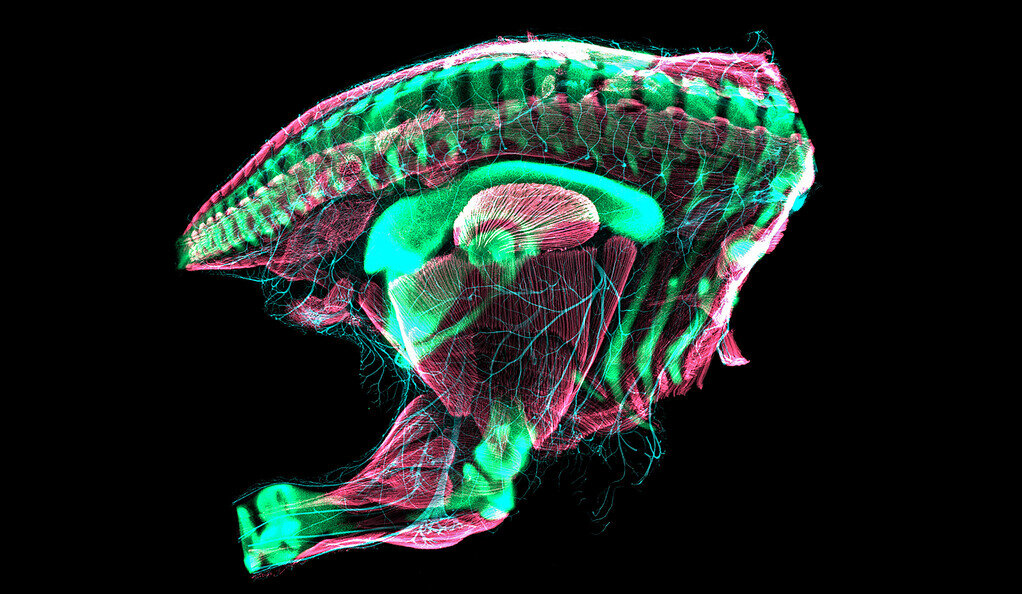Quail embryonic hindquarters imaged with confocal laser scanning microscopy. The skeleton is green, the nerves are blue, and the muscles are red. This quail embryo’s pelvis has just transformed into a relatively “modern” bird configuration. Photo credits: Christopher T. Griffin and Bhart-Anjan S. Bhullar
All baby birds have a moment before hatching when their hip bone is a tiny replica of a dinosaur’s pelvis.
That’s one of the findings of a new Yale-led study in the journal Nature which explores the evolutionary basis of the bird hip bone. It’s also a modern nod to the dramatic transformation that took place from dinosaurs to birds over tens of millions of years.
“Every single bird possesses this dinosaur shape early in life,” said Bhart-Anjan S. Bhullar, assistant professor of Earth and Planetary Sciences at Yale and senior and corresponding author of the new study. “Then at the last minute it remembers it’s a bird and needs a bird tank.”
Over the past decade, Bhullar and his collaborators have conducted groundbreaking research on key evolutionary transitions between dinosaur, reptilian and bird species – including the evolution of the dinosaur inner ear, the bird’s beak, the rolling mammalian jaw and vertebrate vision.
Bhullar’s lab is best known for its innovative use of computed tomography (CT) and microscopy to create 3D images of animal embryos.
Christopher Griffin, a postdoctoral researcher in Bhullar’s lab, is the lead author of the study. He and Bhullar and their colleagues studied pelvic development in alligators, domestic chickens, Japanese quail, Chilean tinamou and parakeets, and compared their developmental stages to those of dinosaurs, including the feathered species Archeopteryx.

Embryonic budgie imaged with confocal laser scanning microscopy. The skeleton is green, the nerves are blue, and the muscles are red. This embryonic bird’s pelvis resembles that of earlier dinosaurs such as Velociraptor. Photo credits: Christopher T. Griffin, Daniel Smith-Paredes and Bhart-Anjan S. Bhullar
For the study, the team tagged embryonic hip bones with antibodies to look for proteins expressed in developing cartilage, connective tissue, skeletal muscle and nerves. Researchers created 3D images for the hip bones, muscles and nerves using confocal microscopes and CT scans.
They found that the bird pelvis is an example of “terminal addition,” a biological mechanism by which ancestral traits appear in an animal late in its development. This came as a surprise, Griffin noted, since many important features in the transition from dinosaur to bird, such as the bird’s beak, are seen early in a bird’s embryonic development.
“It was unexpected that these early stages of avian evolution looked so much like the hips of an early dinosaur,” Griffin said. “In just two days, the developing embryo changes in a way that reflects how it changed evolutionarily, from an early dinosaur to a modern bird.”
The hip bone is the core of a bird’s body. It runs the length of the bird’s frame, enclosing the torso and allowing a bird to stand, move and support the weight of its entire body.
“The bird’s body is incredibly modified in virtually every way to create an optimized flying machine,” explained Bhullar. “Its body structures are strictly constrained by the necessities of aerospace design.”
The new study also looked at the avian muscles and nerves associated with hip development. The researchers said the development of these systems is not synchronous with bone development – meaning each system is somewhat “decoupled” from the others.
Scientists find the first bird’s beak just under her nose
Christopher T. Griffin et al., The developing bird basin undergoes ancestral dinosaur conditions, Nature (2022). DOI: 10.1038/s41586-022-04982-w
Provided by Yale University
Citation: Evolving bird pelvis undergoing ancestral dinosaur conditions (2022 August 5) Retrieved August 6, 2022 from https://phys.org/news/2022-08-bird-pelvis-ancestral-dinosaurian-conditions.html
This document is protected by copyright. Except for fair trade for the purpose of private study or research, no part may be reproduced without written permission. The content is for informational purposes only.
#developing #bird #basin #conditions #ancestors #dinosaurs


Leave a Comment